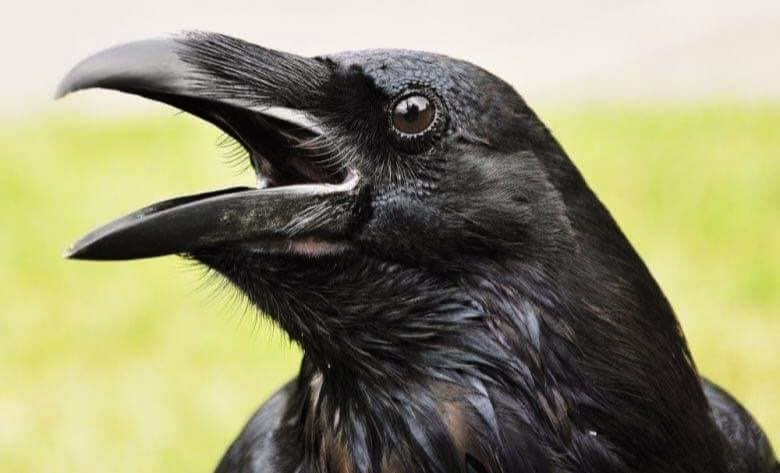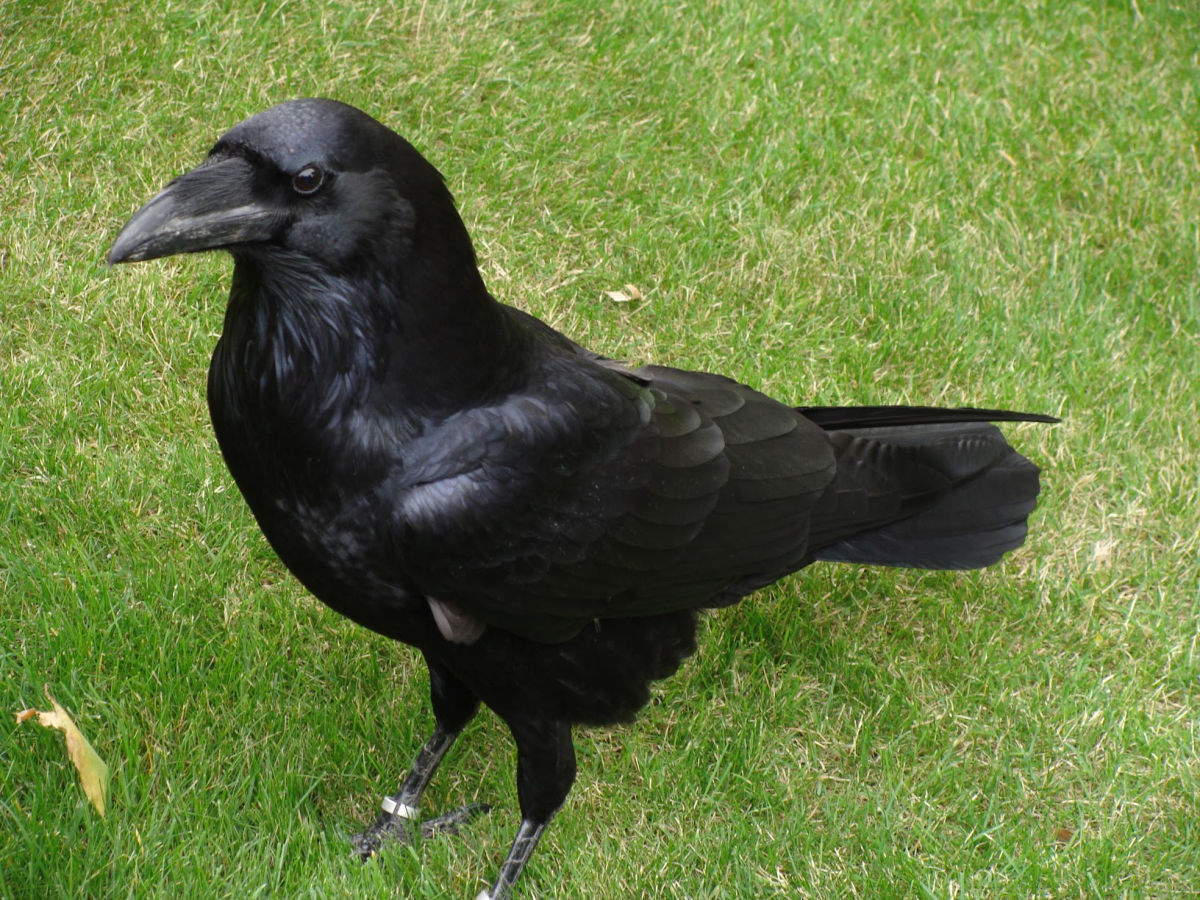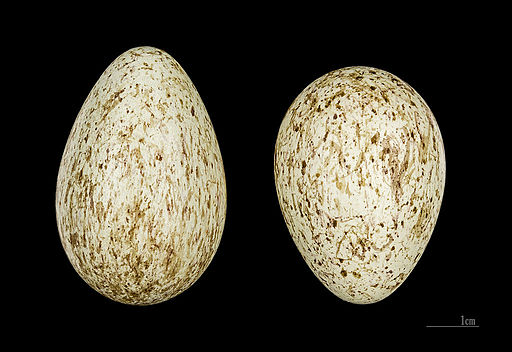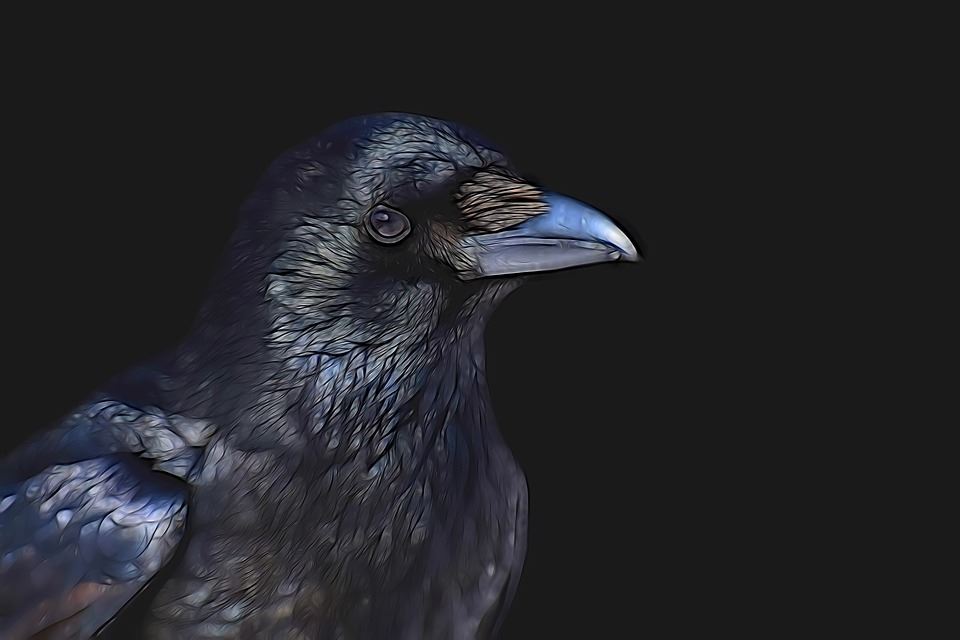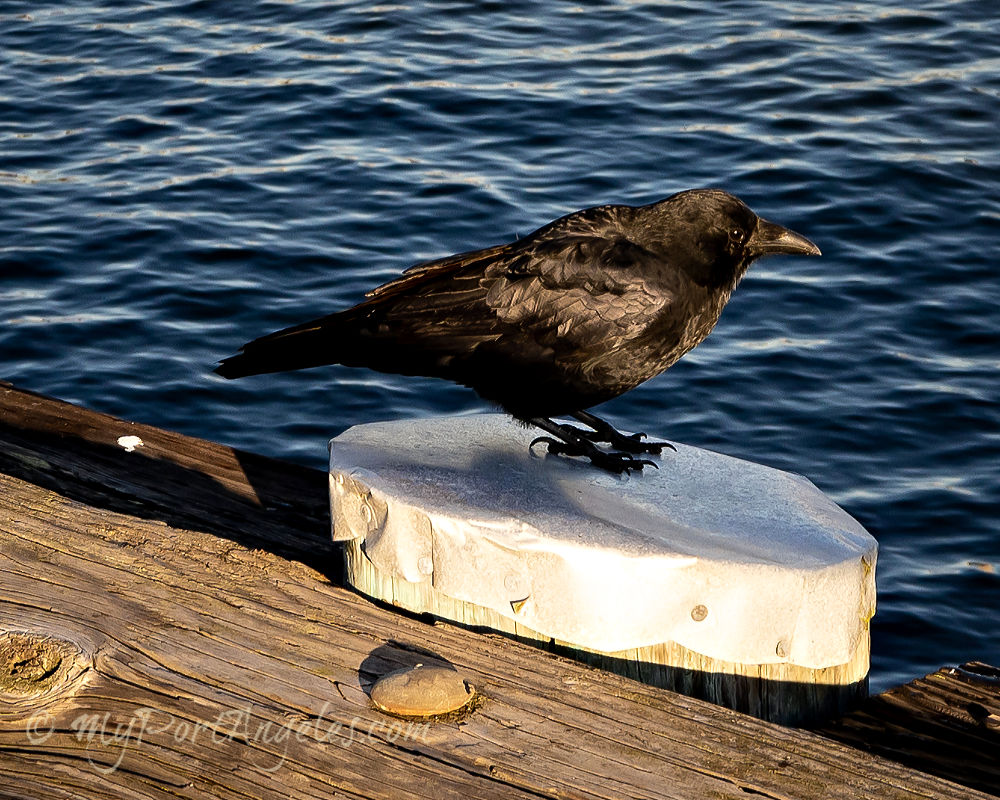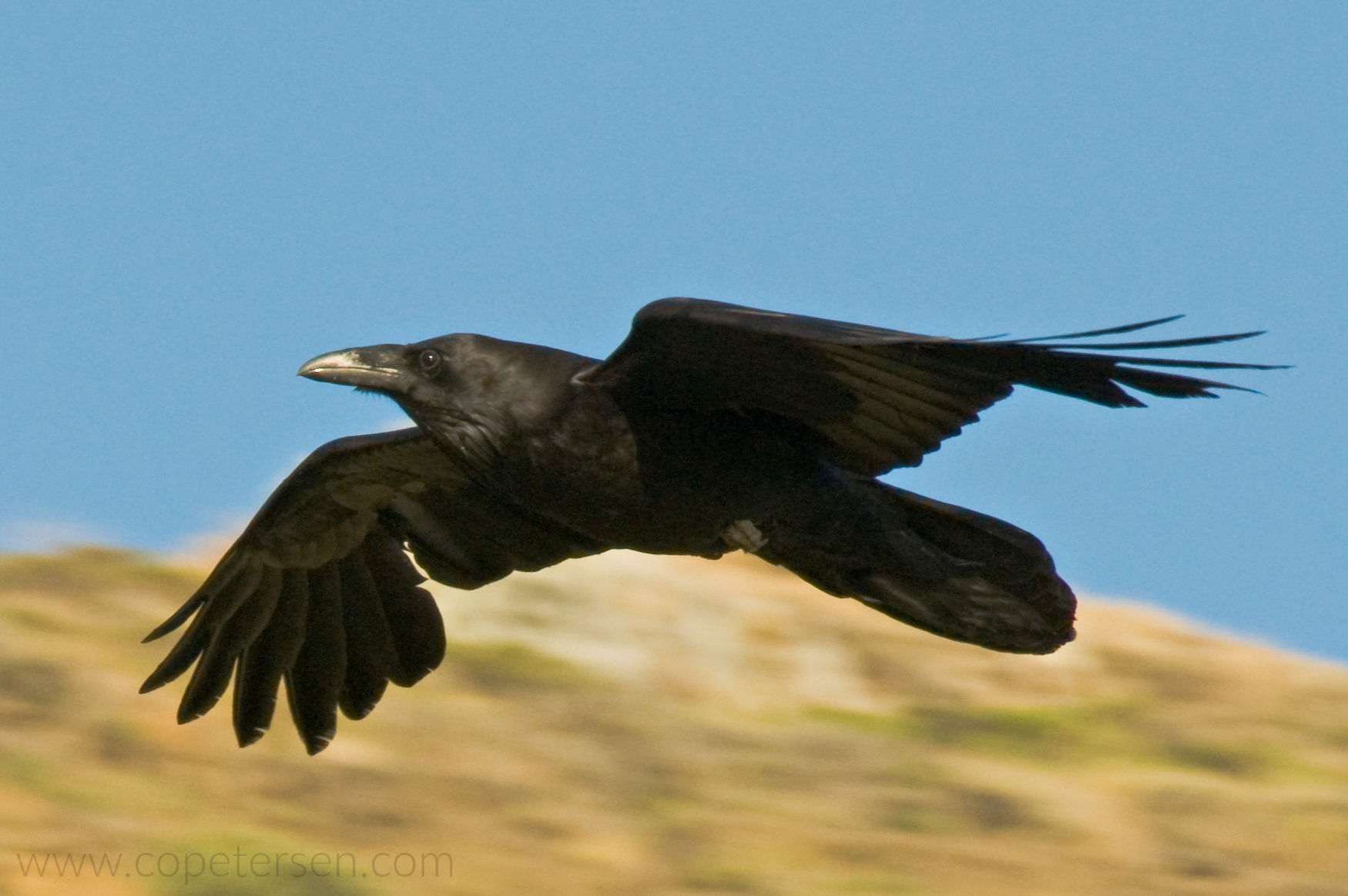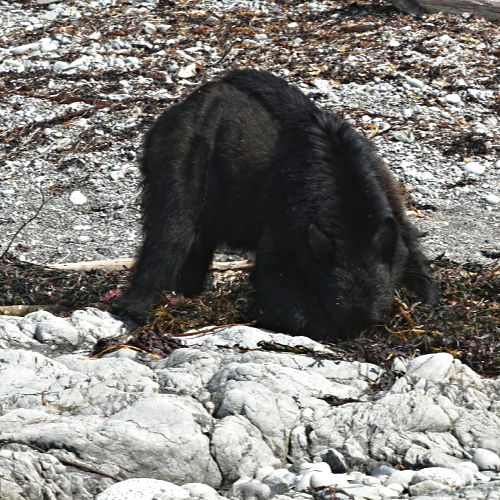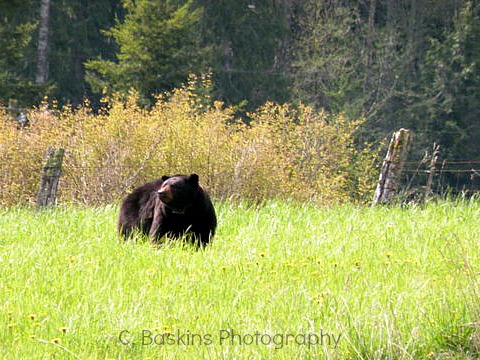Common Raven
Common Raven: The Northern subspecies of the common raven inhabits Port Angeles and the Pacific Northwest. Learn details of raven life, symbolism of the raven in indigenous life, photos, and stories.
"Corvus" means raven in Latin. So in 1758 when the Swedish biologist Linnaeus needed a scientific name, in Latin, for the raven, "Corvus" it was.
The common raven is a part of the Corvidae family of birds. Its genus and species are Corvus corax. The ravens populating the Pacific Northwest are a subspecies, Corvus corax principalis, aptly known as Northern Ravens.
Common Raven: Overview
Ravens have coexisted for with humans for thousands of years, if not longer. The common raven is nearly ubiquitous throughout the Northern Hemisphere. Today, their populations throughout the Americas alone are estimated at around 7.7 million.
It is thought that there are eight subspecies (some scientists say 13) of the common raven. All of them are pitch black, and look quite alike. For some of these subspecies, a study of mitochondrial DNA has been required to trace the differences. For example:
- The Northern Raven lives throughout the Pacific Northwest and down into Northern California, but not as far south as Southern California.
- The ravens in Southern Californian known as western ravens (C. c. sinuatus) are related more strongly to Chihuahuan ravens (C. cryptoleucus) in Mexico than to the Northern Raven.
The various subspecies are found in most of the Unites States, Canada and Mexico, the northern regions of Africa, throughout Europe, and into Asia and Russia. Even Greenland has ravens - the same Northern subspecies that lives on the Olympic Peninsula.
Their extreme success as a species is thought to be due to their intelligence as well as their versatility and extreme opportunism in hunting and food choices.
Today, when referring collectively to a group of ravens, people usually use the generic term "flock." But, it is still technically correct to call a flock of ravens an "unkindness" of ravens, or a "conspiracy" of ravens.
The Common Raven's Appearance
The common raven is glossy black from tip to tail. Even its eyes are dark brown in color. It is one of the largest corvids, weighing between 1.5 and 4.4 pounds (0.69 and 2 kg), and measuring in length between 21 inches and 26 inches long (54 cm and 67 cm) from beak to tail.
Its wingspan measures on average between 45 inches and 51 inches (115 cm and 150 cm) and when in flight, its wedge shaped tail is evident.
Interestingly, their raven-black feathers keep them cool in the heat, according to Audubon.org. This is because the jet-black feathers trap the heat of the sun above the down feathers, so that as a breeze ruffles the feathers, all the trapped heat easily and quickly dissipates.
Family Life of the Common Raven
Habitat
Open areas and coastal regions are the preferred habitats of ravens, due to their habits of hunting, scavenging, raiding the kills of others, and plundering the garbage cans surrounding human habitations.
Courtship to Fledging
Young common ravens like to hang out in groups, or "conspiracies," meaning flocks. But once they reach adulthood, they will usually mate for life. Adult ravens are much more likely to be found singly or in pairs, and within the range they have chosen.
Ravens engage in courtship displays. The male performs aerial acrobatics and tumbling high in the air. The pair may soar and swoop together, or when at rest, touch bills and preen each other.
Soon they will need a nest, which is likely to be built on a rock cliff ledge or high up in a conifer tree. It is common for a pair to continue to use their same nest year after year, simply building it up and shaping a new nest on top of the old one. Their prickly nests are fashioned of large sticks and twigs with a smooth lined depression in the center which will hold their brood.
Mrs. Raven lays three to seven eggs in February, or possibly in March or April if the weather is colder. Her pale bluish green eggs are blotched and streaked with brown marks. She will incubate her eggs by herself for about 18 to 21 days while her mate supplies her meals.
Once hatched, both parents forage for the nestlings. This phase lasts 5-6 weeks, until the youngsters finally leave the nest, or fledge. The youngsters stay in the area, at least partially dependent on their parents, for an additional 6 months. But eventually each flies away and far afield, looking for terrain that will make a perfect home territory, and finally, after two or three years, bonding with mates of their own.
Lifespan
A common raven's predicted lifespan in the wild is about 10 to 15 years, although they have been known to live in captivity or in protected conditions for more than 40 years.
Hunting and Feeding Habits of the Raven
The common raven is extremely successful as a species, most likely because they are not picky eaters. Ravens are omnivores, feeding on practically anything it can sink its talons in.
On the menu are insects, caterpillars, grains, berries, fruit, small animals such as mice, voles, frogs, lizards, and nesting birds with their eggs and nestlings. Nor is a mated pair averse to ganging up on larger birds such as bald eagles and pestering them until they drop or abandon their kill to the ravens.
They are completely fine with dining on carrion whether on land or in water. In some areas, carrion may make up the majority of a raven's diet.
Lastly, the many ravens living in the suburbs among humans also scavenge for food among our garbage cans and dumps. Raven populations in the suburbs have actually risen as human populations have grown, thanks both to our garbage and to roadkill that the common raven is happy to take home to the wife and kids.
Intelligence of the Common Raven
Ravens are incredibly intelligent birds, with very large brains, comparatively. They can imitate human speech and are particularly gifted with figuring out problems. They have unzipped zippers and unfastened velcro strips in order to remove obstacles between them and their meals.
But that is not all that they can do:
- Along with problem-solving skills, they display cognitive processes such as imitation and insight
- They are able to learn from the successes of other ravens
- Ravens, humans, bees, and ants are the only four animals known to communicate information not in the here-and-now. For example, a young unmated raven was seen finding a large carcass guarded by a pair of adult ravens. It returned to its roost in the evening and communicated the discovery. In the morning, the entire "conspiracy" of unmated juvenile ravens flew directly out to the carcass and together as a gang dispossessed the ravens guarding the find.
- They are known to call a wolf pack to a carcass for the purpose of opening it up. Yes, the wolves eat some, but the ravens will also get enough access that they'll carry away portions and create hidden food caches with them.
- On the other hand, they can intentionally deceive. In the case of the large carcass, some ravens watch where other ravens stash their cache, and then they go raid it. Other ravens pretend to make and hide a cache but don't actually hide any meat there. Still other experienced ravens will simply fly much farther afield to hide their cache of food, in hope that the hiding place will be better and most ravens would not fly the distance to steal the cache.
- They are very playful! They break off twigs for the apparently sole purpose of playing with it. They fluff around in snowbanks for the fun of it, taunt wolves, otters, and dogs, and fly loop-de-loops in the air.
Check out the following short video about Fable, the talking raven!
This is a great peak into the intelligence of these beautiful birds....
Differences between a Crow and a Raven
At first glance it might be easy to confuse these two species of birds. They look nearly alike, and if they are not perched side by side, the confusion might remain. Thankfully, there are a few obvious differences, if you are alert:
- Ravens are significantly larger in size than crows. The raven is about the size of a red tailed hawk, while the American crow is about the size of a pigeon.
- Raven beaks are comparatively larger than crow beaks.
- A raven's tail shape differs from a crow's. Ravens have wedge-shaped tails, while a crow's is fan shaped.
- Ravens display different flight patterns than do crows. Ravens tend to soar, and are able to perform air tricks while flying. Crows need to flap their wings more frequently.
- Raven wings cover a larger wing area than to crow wings.
- While only immature ravens hang together in flocks, or "conspiracies," crows are commonly seen in larger flocks, known as "murders."
See: The Definitive Guide for Distinguishing American Crows from Common Ravens
For those who appreciate visuals, the following video does a great job of SHOWING us the differences between crows and ravens.
About those Northwestern Crows...
The Northwestern Crow (Corvus caurinus) is a different and slightly smaller species of crow than the typical American crow (Corvus brachyrhynchos). The traditional habitat of Northwestern crows includes the coastal regions of the northwestern United States and Canada, from Washington's Olympic Peninsula including Port Angeles, the Seattle area, along the coast of British Columbia and throughout Alaska.
Recent genetic research now reveals that all the crows from BC south and into coastal Oregon are actually a highly hybridized mix of Northwestern and American crows.
Today, only coastal Alaska contains truly pure populations of Northwestern Crows.
See Distinguishing between Northwestern Crows and American Crows, a post by the Corvid Research Blog.
The Common Raven in Indigenous Culture
For hundreds of years, indigenous cultures around the world (including our indigenous tribes in the Pacific Northwest) have revered ravens as spiritual figures, or godlike creatures, perhaps due to their acute intelligence.
Dozens, even hundreds of traditional fables have been passed down through the generations. Raven is said to be "the Creator of the world," but it is also considered a "trickster god." The raven is also a symbol of change and transformation.
Pacific Northwest tribes that have various beliefs and traditions regarding the raven include the Tsimishians, Haidas, Heiltsuks, Tlingits, Kwakwaka'wakw, Coast Salish, Koyukons, and Inuit, and others.
Stories about Raven include those where he gives light to the world in different ways, stories of his trickeries, and stories of Raven depositing the earths land and fresh water sources such as lakes, rivers and streams.
The following is a legend told on the Haida Gwaii Islands, formerly known as the Queen Charlotte Islands, off the Pacific Coast of Canada. This tale is a detailed recollection of how Raven brought the Sun, Moon, Stars, and fresh water to a world without light and fresh water.
“Long ago, near the beginning of the world, Gray Eagle was the guardian of the Sun, Moon and Stars, of fresh water, and of fire. Gray Eagle hated people so much that he kept these things hidden. People lived in darkness, without fire and without fresh water.
Gray Eagle had a beautiful daughter, and Raven fell in love with her. In the beginning, Raven was a snow-white bird, and as a such, he pleased Gray Eagle's daughter. She invited him to her father's longhouse.
When Raven saw the Sun, Moon and stars, and fresh water hanging on the sides of Eagle's lodge, he knew what he should do. He watched for his chance to seize them when no one was looking. He stole all of them, and a brand of fire also, and flew out of the longhouse through the smoke hole. As soon as Raven got outside he hung the Sun up in the sky. It made so much light that he was able to fly far out to an island in the middle of the ocean. When the Sun set, he fastened the Moon up in the sky and hung the stars around in different places. By this new light he kept on flying, carrying with him the fresh water and the brand of fire he had stolen.
He flew back over the land. When he had reached the right place, he dropped all the water he had stolen. It fell to the ground and there became the source of all the fresh-water streams and lakes in the world. Then Raven flew on, holding the brand of fire in his bill. The smoke from the fire blew back over his white feathers and made them black. When his bill began to burn, he had to drop the firebrand. It struck rocks and hid itself within them. That is why, if you strike two stones together, sparks of fire will drop out.
Raven's feathers never became white again after they were blackened by the smoke from the firebrand. That is why Raven is now a black bird.”
The Raven in Popular Culture
The Raven was present in the last century's popular culture, inspiring movies, books, poems, music, theater, art, and video games. Perhaps the most famous of these is Edgar Allen Poe's dark Gothic poem, "The Raven," which has itself inspired countless works of art and made the symbol of the raven that much more attractive and popular today.
In today's culture the raven is sometimes seen as a dark omen or a sign of evil. If a raven happens to fly overhead, you might fear that its presence portends dark activities or impending doom.
Gothic photography and art also tends to include ravens in the scene, for the purpose of giving the image a somber or gloomy setting. Ravens are the symbol that communicates the darker aesthetic of an image and elicits emotions in the viewer which are appropriate when contemplating a dark, yet beautiful image.
Whether you consider a raven to be a dark omen or not, the common raven is still a magnificent and beautiful bird.
Tell Us Your Own Raven Story and Share Your Photos With Us!
Some of you have told us about your cool Raven experiences! We'd very much appreciate it if you would share your Raven stories here on our website, along with some exceptional photos if you have them! We know that other visitors will enjoy these stories and seeing the photos as well!
Just click into the title box below and go from there. When published, you'll have "your own" page on MyPortAngeles which you can share with friends or anyone who asks!
We're happy to ensure professional and amateur photographers get credit for their work. Leave us your name in the form below, and means of contact, website, or FB page info so we can link back to you.
